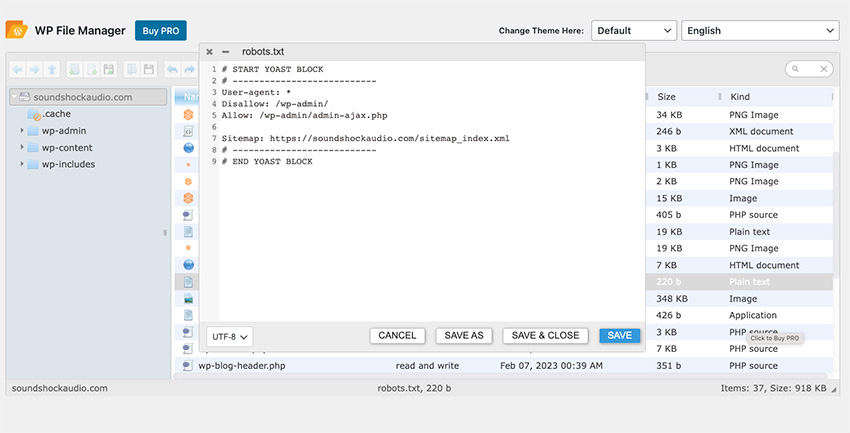Efficiently modify Robots.txt files in WordPress
You are not sure what the robots.txt file is? Do you need to make changes to your robots.txt file but don't know how to access it?

robots.txt The file is crucial for any website as it helps control the behavior of search engines and other web robots. This text file acts as a set of instructions that tells search engines and other robots which pages or sections of your website should be crawled or indexed.
In this article, we will discuss finding and editing the robots.txt file in WordPress. Whether you want to block specific pages, allow search engines to crawl your entire site, or disable crawling of specific file types, knowing how to edit your robots.txt file is an important step in controlling your website's presence on the internet. .
By following these steps, you can quickly and easily edit the robots.txt file in your WordPress site and improve your site’s SEO and sensitive information protection.
Find and edit the robots.txt file
To make changes to your website’s robots.txt file, you first need to access it.
In this section, we’ll walk you through the steps to access the robots.txt file in WordPress so you can make changes to it.
Install WP File Manager

To find the robots.txt file, you will need to access your WordPress website’s file manager.
You can access your site’s files via FTP, but it’s easier to install the WP File Manager plugin. The plugin will display your website’s files for quick editing directly from the WordPress dashboard.
Navigate to the Plugins section in the side menu. Search for WP File Manager in the search bar. Click the Add button to access the WordPress plugin. Click Install Now and wait for the plug-in to be installed, then click the Activate button to activate your Plugins on the website.
You will now see the WP File Manager on the left sidebar of your WP dashboard.
Findrobots.txtFile

After opening the file manager in your WordPress control panel, the next step is to locate the robots.txt file. The robots.txt file is typically located in the root directory of your WordPress website and can usually be found by browsing the directory structure in your file manager. To find the file, look for the file named robots.txt and select it.
If you can't find the robots.txt file, you can also use the search function in your file manager to quickly find it. Enter "robots.txt" in the search bar and press Enter. This should display the file in search results, and you can then select it to open it in a file editor.
EditRobots.txtFile

After finding the robots.txt file, right-click the file and a list of options will appear. Select the Code Editor option. A code editor will now appear where you can make the necessary changes.
After making changes to the file, click the Save and Close button. Your changes will now be saved.
It is important to check and update the robots.txt file regularly to ensure it reflects the current status of your site and provides necessary instructions to search engine robots.
Download Popular WordPress Plugins
WordPress plugins are crucial to the success of your website. The article below will help you get tons of high-quality plugins that you can add to your WP website in no time.
Quickly edit the website’s Robots.txt file
By following the steps outlined in this article, you can quickly and easily access, find, and change the robots.txt file on your WordPress site.
Whether you want to prevent search engines from indexing specific pages, allow search engines to crawl your entire site, or disable crawling of specific file types, learn how to edit robots.txt strong> Documentation is an important step in controlling your website's presence on the internet.
Check out all the great tools for WordPress and other creative projects, and get unlimited access to Envato Elements.
The above is the detailed content of Efficiently modify Robots.txt files in WordPress. For more information, please follow other related articles on the PHP Chinese website!

Hot AI Tools

Undresser.AI Undress
AI-powered app for creating realistic nude photos

AI Clothes Remover
Online AI tool for removing clothes from photos.

Undress AI Tool
Undress images for free

Clothoff.io
AI clothes remover

Video Face Swap
Swap faces in any video effortlessly with our completely free AI face swap tool!

Hot Article

Hot Tools

Notepad++7.3.1
Easy-to-use and free code editor

SublimeText3 Chinese version
Chinese version, very easy to use

Zend Studio 13.0.1
Powerful PHP integrated development environment

Dreamweaver CS6
Visual web development tools

SublimeText3 Mac version
God-level code editing software (SublimeText3)

Hot Topics
 1387
1387
 52
52
 Is WordPress easy for beginners?
Apr 03, 2025 am 12:02 AM
Is WordPress easy for beginners?
Apr 03, 2025 am 12:02 AM
WordPress is easy for beginners to get started. 1. After logging into the background, the user interface is intuitive and the simple dashboard provides all the necessary function links. 2. Basic operations include creating and editing content. The WYSIWYG editor simplifies content creation. 3. Beginners can expand website functions through plug-ins and themes, and the learning curve exists but can be mastered through practice.
 How To Begin A WordPress Blog: A Step-By-Step Guide For Beginners
Apr 17, 2025 am 08:25 AM
How To Begin A WordPress Blog: A Step-By-Step Guide For Beginners
Apr 17, 2025 am 08:25 AM
Blogs are the ideal platform for people to express their opinions, opinions and opinions online. Many newbies are eager to build their own website but are hesitant to worry about technical barriers or cost issues. However, as the platform continues to evolve to meet the capabilities and needs of beginners, it is now starting to become easier than ever. This article will guide you step by step how to build a WordPress blog, from theme selection to using plugins to improve security and performance, helping you create your own website easily. Choose a blog topic and direction Before purchasing a domain name or registering a host, it is best to identify the topics you plan to cover. Personal websites can revolve around travel, cooking, product reviews, music or any hobby that sparks your interests. Focusing on areas you are truly interested in can encourage continuous writing
 What is the WordPress good for?
Apr 07, 2025 am 12:06 AM
What is the WordPress good for?
Apr 07, 2025 am 12:06 AM
WordPressisgoodforvirtuallyanywebprojectduetoitsversatilityasaCMS.Itexcelsin:1)user-friendliness,allowingeasywebsitesetup;2)flexibilityandcustomizationwithnumerousthemesandplugins;3)SEOoptimization;and4)strongcommunitysupport,thoughusersmustmanageper
 Can I learn WordPress in 3 days?
Apr 09, 2025 am 12:16 AM
Can I learn WordPress in 3 days?
Apr 09, 2025 am 12:16 AM
Can learn WordPress within three days. 1. Master basic knowledge, such as themes, plug-ins, etc. 2. Understand the core functions, including installation and working principles. 3. Learn basic and advanced usage through examples. 4. Understand debugging techniques and performance optimization suggestions.
 How much does WordPress cost?
Apr 05, 2025 am 12:13 AM
How much does WordPress cost?
Apr 05, 2025 am 12:13 AM
WordPress itself is free, but it costs extra to use: 1. WordPress.com offers a package ranging from free to paid, with prices ranging from a few dollars per month to dozens of dollars; 2. WordPress.org requires purchasing a domain name (10-20 US dollars per year) and hosting services (5-50 US dollars per month); 3. Most plug-ins and themes are free, and the paid price ranges from tens to hundreds of dollars; by choosing the right hosting service, using plug-ins and themes reasonably, and regularly maintaining and optimizing, the cost of WordPress can be effectively controlled and optimized.
 Should I use Wix or WordPress?
Apr 06, 2025 am 12:11 AM
Should I use Wix or WordPress?
Apr 06, 2025 am 12:11 AM
Wix is suitable for users who have no programming experience, and WordPress is suitable for users who want more control and expansion capabilities. 1) Wix provides drag-and-drop editors and rich templates, making it easy to quickly build a website. 2) As an open source CMS, WordPress has a huge community and plug-in ecosystem, supporting in-depth customization and expansion.
 Is WordPress still free?
Apr 04, 2025 am 12:06 AM
Is WordPress still free?
Apr 04, 2025 am 12:06 AM
The core version of WordPress is free, but other fees may be incurred during use. 1. Domain names and hosting services require payment. 2. Advanced themes and plug-ins may be charged. 3. Professional services and advanced features may be charged.
 Why would anyone use WordPress?
Apr 02, 2025 pm 02:57 PM
Why would anyone use WordPress?
Apr 02, 2025 pm 02:57 PM
People choose to use WordPress because of its power and flexibility. 1) WordPress is an open source CMS with strong ease of use and scalability, suitable for various website needs. 2) It has rich themes and plugins, a huge ecosystem and strong community support. 3) The working principle of WordPress is based on themes, plug-ins and core functions, and uses PHP and MySQL to process data, and supports performance optimization.




